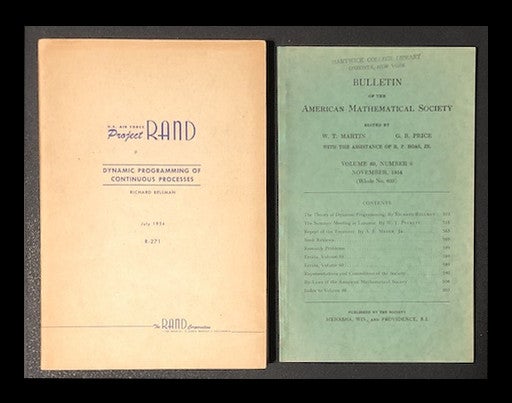Dynamic Programming of Continuous Processes in Rand Corporation R-271 pp. 1-141, 1954 WITH The Theory of Dynamic Programming in Bulletin of the American Mathematical Society 60 No. 6 pp. 503-515, November 1954
1954. 1st Edition. FIRST EDITION IN ORIGINAL WRAPPERS OF TWO PAPERS BY BELLMAN MARKING THE BIRTH OF DYNAMIC PROGRAMMING. “These are the seminal papers by Bellman on Dynamic Programming. The first is a 141-page report on dynamic programming and the second is a speech on the theory underlying it.
Richard E. Bellman’s invention of dynamic programming in 1953 (published in these two papers) was a major breakthrough in the theory of multistage decision processes - a breakthrough which set the stage for the application of functional equation techniques in a wide spectrum of fields extending far beyond the problem-areas which provided the initial motivation for his ideas. This work marked the beginning of a new era in the analysis and optimization of large-scale systems and opened a way for the application of sophisticated computer-oriented techniques in a wide variety of problem-areas ranging from the design of guidance systems for space vehicles to pest control and network optimization” (Richard Bellman Biography, ETHW).
Describing his theory of dynamic programming (in the paper with the same name included here), Bellman wrote: “To begin with, the theory was created to treat the mathematical problems arising from the study of various multi-stage decision processes, which may roughly be described in the following way: We have a physical system whose state at any time / is determined by a set of quantities which we call state parameters, or state variables. At certain times, which may be prescribed in advance, or which may be determined by the process itself, we are called upon to make decisions which will affect the state of the system. These decisions are equivalent to transformations of the state variables, the choice of a decision being identical with the choice of a transformation.
The outcome of the preceding decisions is to be used to guide the choice of future ones, with the purpose of the whole process that of maximizing some function of the parameters describing the final state” (Bellman, “The Theory of Dynamic Programming,” 503).
When Bellman was awarded the IEEE Medal of Honor in 1979 "for contributions to decision processes and control system theory, particularly the creation and application of dynamic programming," the citation continued: "Richard Bellman is a towering figure among the contributors to modern control theory and systems analysis. His invention of dynamic programming marked the beginning of a new era in the analysis and optimization of large-scale systems and opened a way for the application of sophisticated computer-oriented techniques in a wide variety of problem areas ranging from the design of guidance systems for space vehicles to pest control and network optimization" (IEEE Transactions, 24, 3, 385, June 1979). Item #1299
CONDITION & DETAILS: The Rand document is pristine inside and out. The Bulletin is pristine with the exception of a quite light library stamp on the front cover and a professionally (and almost invisibly) repaired spine. Both are exceptionally bright and clean.
Price: $525.00

